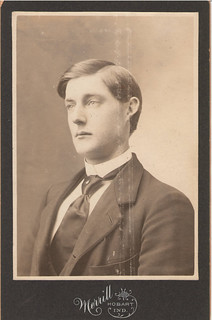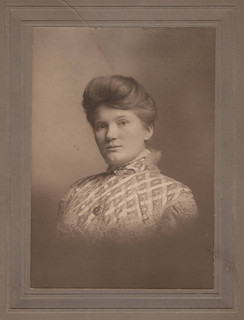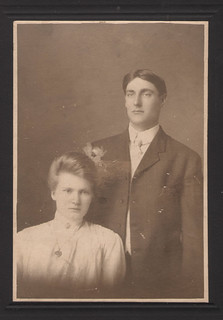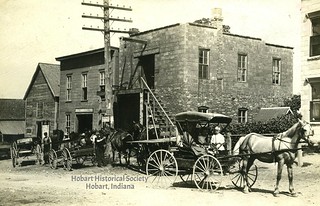
(Click on images to enlarge)
Nels Gustaf Lindborg as a young man, circa 1902. (From a private collection.)
After Ed Sauter lost everything and left Ainsworth in 1905, the town seems to have been without a blacksmith for a couple of years. Dancers still danced in the hall; drinkers still drank in the saloon; but the forge was cold and the hammer and anvil silent.
In March 1908, the Hobart Gazette carried this modest announcement:
G. Lindborg, the Ainsworth blacksmith, is prepared to do all kinds of general blacksmithing, horseshoeing and repairing of wagons, buggies and machinery."G. Lindborg" was Nels Gustaf Lindborg (or Gustaf Nels — he never could decide on the order of his Christian names), a 25-year-old Swedish immigrant. He was the new blacksmith of Ainsworth; he would be the life-long blacksmith of Ainsworth and the last blacksmith of Ainsworth.
There is nothing in the Gazette to indicate whether Gust had bought Ed Sauter's property from the First State Bank, or was merely renting it, as Claus Ziegler had done after the sheriff's sale. In the years to come, however, the Lindborg family would certainly own both the blacksmith shop and the dance hall, up until the day when the century-old buildings had to be demolished.
With Gust came his wife, Anna (née Palm), also 25 years old.

Anna Palm Lindborg, circa 1910. (From a private collection.)
Although Gust and Anna had both grown up near each other in the Tomalilla region of Sweden, they never met until after they came to the United States (she in 1901, he in 1902). It was probably in Hegewisch, Illinois, where both lived for a while, that they finally met and fell in love.
They were married on March 3, 1906.

Wedding photo of Gust and Anna Palm Lindborg, 1906. (From a private collection.)
By the time they came to Ainsworth, they already had a daughter, Mildred, born December 6, 1906. Their first son, Franklin, was born in Ainsworth on New Year's Eve 1908.
I don't know exactly where they lived when they first moved here. Perhaps they moved directly into the little house that would serve as Gust and Anna's home throughout their lives. It had been built as a schoolhouse somewhere south of Route 30 and later was moved to Ainsworth, to the west side of the dance hall. I believe it replaced that barn-like structure with the peaked roof in the photo below (which we've seen before):

(Image courtesy of the Hobart Historical Society.)
Their house is still standing at 6310 Ainsworth Road. It was smaller when the Lindborgs first lived there; not until the early 1930s was the front porch enclosed, and a kitchen/dining room added to the back — along with an indoor bathroom. Originally, the kitchen and dining room had been in the basement, and the bathroom had been an outhouse in the back yard.
The new blacksmith's arrival caused no disruption in Ainsworth's entertainment. Dancers still danced in the hall.
Drinkers still drank in the saloon, too, but that's another story. Henceforward the saloon would be estranged from its sister buildings; the Lindborgs never owned it.
(To be continued)
Sources:
♦ "General News Items." Hobart Gazette 6 Mar. 1908.
♦ "Local Drifts." Hobart Gazette 8 Jan. 1909.
♦ Personal interviews with a Lindborg descendant, Feb. – April 2010.


2 comments:
It's so wonderful being able to find all this info about my house and the people who lived here! We've actually been trying to figure out when the addition was put on, and now i know it was the 30s! I absolutely love all the photos too!!
Hi neighbor! Glad you're enjoying the blog. I hope you discovered (in the index at right) the "image set: Lindborg album" for more photos of the house and its surroundings.
Post a Comment